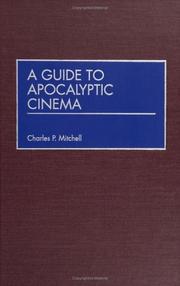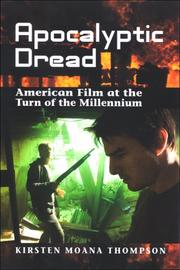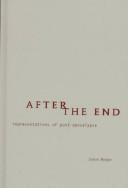| Listing 1 - 7 of 7 |
Sort by
|

ISBN: 0313315272 Year: 2001 Publisher: Westport (Conn.) : Greenwood press,
Abstract | Keywords | Export | Availability | Bookmark
 Loading...
Loading...Choose an application
- Reference Manager
- EndNote
- RefWorks (Direct export to RefWorks)
Apocalypse in motion pictures. --- Science fiction films --- History and criticism.
Book
ISBN: 9781978819849 9781978819856 9781978819863 9781978819870 9781978819887 Year: 2021 Publisher: New Brunswick, N.J. Rutgers University Press
Abstract | Keywords | Export | Availability | Bookmark
 Loading...
Loading...Choose an application
- Reference Manager
- EndNote
- RefWorks (Direct export to RefWorks)
"Movie audiences know exactly how the world will end because popular cinema has never stopped rehearsing the apocalypse. In this clear, concise account, Stephen Prince illuminates the appeal of apocalypse cinema, its roots in literary and religious tradition, its presence throughout cinema history, and the existential fears and anxieties that motivate it. In four elegant chapters, Prince examines the key threats to human existence that bring about world's end - collisions with giant asteroids, invasions by planet-devouring aliens, nuclear war, global warming and deadly pandemics. Touching on films ranging from The End of the World (1916), The Rapture (1991), Signs (2002), Armageddon (1998), Deep Impact (1998), Melancholia (2011), These Final Hours (2015), The War of the Worlds (1953), Invasion of the Body Snatchers (1956), Independence Day (1996), Annihilation (2018), Avengers: Infinity War (2018), Avengers: Endgame (2019) and many more, Apocalypse Cinema shows how apocalypse movies explore fundamental questions of existence that never go out of fashion"--
Apocalypse in motion pictures. --- Apocalyptic films --- History and criticism. --- Film
Book
ISBN: 9781443878807 1443878804 9781443872379 1443872377 Year: 2015 Publisher: Newcastle upon Tyne, England : Cambridge Scholars Publishing,
Abstract | Keywords | Export | Availability | Bookmark
 Loading...
Loading...Choose an application
- Reference Manager
- EndNote
- RefWorks (Direct export to RefWorks)
Apocalyptic Projections have been pondered since Biblical times. Theories abounded in an attempt to prepare for calamity and plan for the future. Worldwide concern regarding a twenty-first century apocalypse, related to the 2012 Mayan Apocalyptic prediction, sparked renewed interest. Even though the concept of apocalypse evokes images of total oblivion, threads of possibility and redemption offer a potential fabric of hope. The majority of the papers included in Apocalyptic Projections were p...

ISBN: 079148033X 142947145X 9781429471459 9780791470435 0791470431 9780791470442 079147044X 9780791480335 Year: 2007 Publisher: Albany : State University of New York Press,
Abstract | Keywords | Export | Availability | Bookmark
 Loading...
Loading...Choose an application
- Reference Manager
- EndNote
- RefWorks (Direct export to RefWorks)
In Apocalyptic Dread, Kirsten Moana Thompson examines how fears and anxieties about the future are reflected in recent American cinema. Through close readings of such films as Cape Fear, Candyman, Dolores Claiborne, Se7en, Signs, and War of the Worlds, Thompson argues that a longstanding American apocalyptic tradition permeates our popular culture, spreading from science-fiction and disaster films into horror, crime, and melodrama. Drawing upon Kierkegaard's notion of dread—that is, a fundamental anxiety and ambivalence about existential choice and the future—Thompson suggests that the apocalyptic dread revealed in these films, and its guiding tropes of violence, retribution, and renewal, also reveal deep-seated anxieties about historical fragmentation and change, anxieties that are in turn displaced onto each film's particular "monster," whether human, demonic, or eschatological.
Apocalypse in motion pictures. --- Science fiction films --- Disaster films --- Horror films --- Catastrophe films --- Disaster movies --- Motion pictures --- Apocalypse as a theme in motion pictures --- History and criticism.

ISBN: 0816629323 0816629331 9780816629336 9780816629329 Year: 1999 Publisher: Minneapolis, Minn. University of Minnesota Press
Abstract | Keywords | Export | Availability | Bookmark
 Loading...
Loading...Choose an application
- Reference Manager
- EndNote
- RefWorks (Direct export to RefWorks)
American literature --- Thematology --- Film --- anno 1900-1999 --- Catastrophical, The --- Apocalyptic literature --- Holocaust, Jewish (1939-1945), in literature --- Judaism and literature --- Apocalypse in motion pictures --- History and criticism --- United States --- Civilization --- Apocalypse in motion pictures. --- Catastrophical, The. --- Holocaust, Jewish (1939-1945), in literature. --- History and criticism. --- Disasters --- Ontology --- Tragic, The --- Change --- Apocalypse as a theme in motion pictures --- Motion pictures --- Apocalyptic literature - History and criticism --- American literature - 20th century - History and criticism --- Judaism and literature - United States --- United States - Civilization - 1970 --- -American literature
Book
ISBN: 1906924511 1906924503 2821817088 190692452X 9781906924522 1906924619 Year: 2011 Publisher: Cambridge : OpenBook Publishers,
Abstract | Keywords | Export | Availability | Bookmark
 Loading...
Loading...Choose an application
- Reference Manager
- EndNote
- RefWorks (Direct export to RefWorks)
This book examines historical and imaginary scenarios of apocalypse, the depiction of its likely triggers, and imagined landscapes in the aftermath of global destruction. Its discussion moves effortlessly from classic novels including Aldous Huxleys Brave New World, George Orwells Nineteen Eighty-Four and Margaret Atwoods Oryx and Crake, to blockbuster films such as Blade Runner, Armageddon and The Terminator. The author also takes into account religious doctrine, scientific research and the visual arts to create a penetrating, multi-disciplinary study that provides profound insight into one of Western cultures darkest and most enduring preoccupations.
Apocalypse in art. --- Apocalypse in literature. --- Apocalypse in motion pictures. --- End of the world. --- Religion --- Philosophy & Religion --- Christianity --- Apocalypse as a theme in motion pictures --- World, End of the --- Motion pictures --- Eschatology --- literature --- oryx and crake --- margaret atwood --- cultural studies --- douglas adams --- terminator --- blade runner --- george orwell --- apocalypse --- aldous huxley --- john wyndham --- nineteen eighty-four --- 1984 --- brave new world --- film studies --- armageddon --- harry potter --- Utopia
Book
ISBN: 0813593689 9780813593685 9780813593654 9780813593647 0813593646 0813593654 9780813593654 Year: 2019 Publisher: New Brunswick, NJ
Abstract | Keywords | Export | Availability | Bookmark
 Loading...
Loading...Choose an application
- Reference Manager
- EndNote
- RefWorks (Direct export to RefWorks)
Undead Ends is about how we imagine humanness and survival in the aftermath of disaster. This book frames modern British and American apocalypse films as sites of interpretive struggle. It asks what, exactly, is ending? Whose dreams of starting over take center stage, and why? And how do these films, sometimes in spite of themselves, make room to dream of new beginnings that don't just reboot the world we know? Trimble argues that contemporary apocalypse films aren't so much envisioning The End of the world as the end of a particular world; not The End of humanness but, rather, the end of Man. Through readings of The Road, I Am Legend, 28 Days Later, 28 Weeks Later, Children of Men, and Beasts of the Southern Wild, this book demonstrates that popular stories of apocalypse can trouble, rather than reproduce, Man's story of humanness. With some creative re-reading, they can even unfold towards unexpected futures. Mainstream apocalypse films are, in short, an occasion to imagine a world After Man.
Apocalyptic films --- Apocalypse in motion pictures. --- Apocalypse as a theme in motion pictures --- Motion pictures --- Doomsday films --- End-of-the-world films --- Post-apocalyptic films --- Post-apocalyptic science fiction films --- Postapocalyptic films --- Postapocalyptic science fiction films --- History and criticism. --- 24.31 theory and aesthetics of film art. --- Apocalyptic films. --- LITERARY CRITICISM / Caribbean & Latin American. --- SOCIAL SCIENCE / Black Studies (Global). --- SOCIAL SCIENCE / Feminism & Feminist Theory. --- History and criticism --- Great Britain. --- United States.
| Listing 1 - 7 of 7 |
Sort by
|

 Search
Search Feedback
Feedback About UniCat
About UniCat  Help
Help News
News